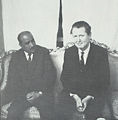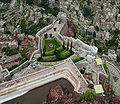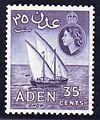

Yemen, officially the Republic of Yemen, is a country in West Asia. Located in southern Arabia, it borders Saudi Arabia to the north, Oman to the northeast, the Red Sea to the west, and the Indian Ocean to the south, sharing maritime borders with Eritrea, Djibouti and Somalia across the Horn of Africa. Covering roughly 528,000 square kilometres (203,861 square miles), with a coastline of approximately 2,000 kilometres (1,200 miles), Yemen is the second largest country on the Arabian Peninsula. Sanaa is its constitutional capital and largest city. Yemen's estimated population is 34.7 million, mostly Arab Muslims. It is a member of the Arab League, the United Nations, the Non-Aligned Movement and the Organisation of Islamic Cooperation.
Owing to its geographic location, Yemen has been at the crossroads of many civilisations for over 7,000 years. In 1200 BCE, the Sabaeans formed a thriving commercial kingdom that included parts of modern Ethiopia and Eritrea. In 275 CE, it was succeeded by the Himyarite Kingdom, which spanned much of Yemen's present-day territory and was heavily influenced by Judaism. Christianity arrived in the fourth century, followed by the rapid spread of Islam in the seventh century. Yemenite troops played a crucial role in early Islamic conquests. Various dynasties emerged between the 9th and 16th centuries. During the 19th century, the country was divided between the Ottoman and British empires. After World War I, the Kingdom of Yemen was established, which in 1962 became the Yemen Arab Republic (North Yemen) following a coup. In 1967, the British Aden Protectorate became the independent People's Democratic Republic of Yemen (South Yemen), the first and only officially socialist state in the Arab world. In 1990, the two Yemeni states united to form the modern Republic of Yemen, with Ali Abdullah Saleh serving as the first president until his resignation in 2012 in the wake of the Arab Spring.
Since 2011, Yemen has been enduring a political crisis, marked by street protests against poverty, unemployment, corruption, and President Saleh's plan to amend Yemen's constitution and eliminate the presidential term limit. By 2015, the country became engulfed by an ongoing civil war with multiple entities vying for governance, including the Presidential Leadership Council of the internationally recognized government, and the Houthi movement's Supreme Political Council. This conflict, which has escalated to involve various foreign powers, has led to a severe humanitarian crisis. (Full article...)

The Bab-el-Mandeb (Arabic: باب المندب, lit. 'Gate of Lamentation', Tigrinya: ባብ ኣል ማንዳብ), the Gate of Grief or the Gate of Tears, is a strait between Yemen on the Arabian Peninsula and Djibouti and Eritrea in the Horn of Africa. It connects the Red Sea to the Gulf of Aden and by extension the Indian Ocean. (Full article...)
List of selected articles
|
|---|
Tawakkol Abdel-Salam Khalid Karman (Arabic: توكل عبد السلام خالد كرمان, romanized: Tawakkul 'Abd us-Salām Khālid Karmān; Turkish: Tevekkül Karman; born 7 February 1979) is a Yemeni journalist, politician, and human rights activist. She co-founded and leads 'Women Journalists Without Chains', a group established in 2005 to advocate for press freedom and human rights. She became the international public face of the 2011 Yemeni uprising that was part of the Arab Spring movement. She was often referred as the 'Iron Woman' and the 'Mother of the Revolution" in Yemen. She is a co-recipient of the 2011 Nobel Peace Prize for "non-violent struggle for the safety of women and for women's rights to full participation in peace-building work". She became the first Yemeni, the first Arab woman, and the second Muslim woman to win a Nobel Prize.
Karman gained prominence in Yemen after 2005 as a Yemeni journalist and an advocate for press freedom, particularly following the denial of a license for a mobile phone news service in 2007, after which she led protests. After May 2007, she organized weekly protests advocating for broader reforms in Yemen. In early 2011, she shifted the protests to align with the broader Arab Spring movement, inspired by the Tunisian revolution that overthrew the government of Zine El Abidine Ben Ali. She was a vocal opponent who called for the end of President Ali Abdullah Saleh's regime. (Full article...)
List of selected biographies
|
|---|
Hajjah (Arabic: حَجَّة, romanized: Ḥajjah) is the capital city of Hajjah Governorate in north-western Yemen. It is located 127 kilometres northwest of Sana'a, at an elevation of about 1800 metres. As of 2003, the Hajjah City District had a population of 53,887 inhabitants. (Full article...)
Asida (Arabic "عصيدة", Maghrebi "Ġsydë" [ˈʕæs(ˁ)iːdə]) is a common dish in the Arab world. It is a lump of dough, obtained by stirring wheat flour into boiling water, sometimes with added butter or honey. Similar in texture to fufu, it is eaten mainly in Middle East and African countries. It is considered one of the most popular desserts and traditional dishes in many Arab countries. (Full article...)
List of articles
|
|---|
Religions in Yemen
Arab states
Related portals
Religions in Yemen
Arab states
Related portals
The following Wikimedia Foundation sister projects provide more on this subject:
-
Commons
Free media repository -
Wikibooks
Free textbooks and manuals -
Wikidata
Free knowledge base -
Wikinews
Free-content news -
Wikiquote
Collection of quotations -
Wikisource
Free-content library -
Wikiversity
Free learning tools -
Wiktionary
Dictionary and thesaurus









































































